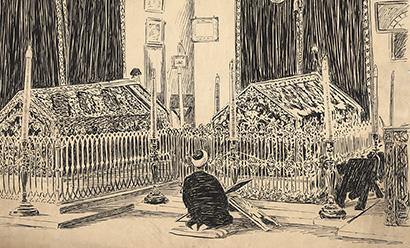German-Ottoman Alliance ›
German-Ottoman Alliance
To meet their shared goals of national protection, territorial expansion and military strength, Germany and the Ottoman Empire formed a military alliance.
“Turkey needed to join one of the country groups so that it could organize its domestic administration, strengthen and maintain its commerce and industry, expand its railroads, in short, to survive and to preserve its existence.”
—Talat Pasha, Minister of Interior, Turkish government
The Ottoman Empire and the faith of Islam interested Kaiser Wilhelm II. He traveled to the Ottoman Empire several times in the decades before WWI, and stated he was “protector” of the Muslim people. At the outbreak of WWI, German leadership restated these claims to promote an alliance.
Postcard, Inscribed. November 15, 1917. 2005.98.446. National WWI Museum and Memorial.
Some members of Ottoman leadership were also eager to form an alliance at the start of WWI. They worried what might happen to their already weakened empire in the face of global war. The small, but powerful, war party saw Germany as a useful friend with money and a large military presence. They signed a secret alliance agreement with Germany on August 2, 1914.
Slide, Magic Lantern. n.d. Sydney, Australia. 2005.75.11. National WWI Museum and Memorial.
"In 1914 not only the masses but most of the intellectuals and leading forces of the Unionists [i.e. the Young Turks] were against the war. Only Enver Pasha and a certain convinced military group, along with the profiteers, were in favor of war."
—Halide Edib Adivar, celebrated Turkish woman writer and activist
"With deep sorrow, I find that the Turkish Government having joined hands with Germany acting under German orders, is madly attempting to wage a most unprovoked war against such mighty sovereigns as the [British] King-Emperor and the Tsar of Russia. This is not the true and free will of the Sultan, but of German officers…. Now that Turkey has so disastrously shown herself a tool in the German hands she has not only ruined herself but has lost her position of Trustee of Islam and evil will overtake her."
—the Aga Khan, head of the Ismaili Muslim community
Not everyone in Turkey supported involvement in the conflict. To change attitudes about the war, German and Ottoman leadership planned on using faith to influence popular opinion. Through joint efforts, they would try to use Islam to gain support in Turkey and around the world.
"I cannot imagine myself fighting in the desert front. And why should I go? To fight for my country? I am Ottoman by name only, for my country is the whole of humanity. Even if I am told that by going to fight, we will conquer Egypt [liberating it from the British], I will refuse to go."
—Ihsan Turjman, from Jerusalem, Palestine, private in Ottoman Army

Print. n.d. Lithograph. 1983.120.101. National WWI Museum and Memorial.
